The hardy potato variety "Lapot" is not afraid of bad weather
Potatoes with a purely peasant name Lapot have been tested by more than one generation of vegetable growers. This variety has been known for more than half a century - during this time it has not lost its relevance. Despite the varietal variety of domestic and foreign producers, it remains a favorite on numerous beds. The crop is high-yielding, with good adaptation to any climate, while it is characterized by unprecedented ease of care.
The content of the article
Description of the variety
The main indicators are mid-early ripening, high yield and large tubers.
The bush is medium-sized - no more than 60 cm, spreading. The foliage is dense, the leaves are medium-sized, light green. When blooming, large snow-white flowers are formed.
The plant exhibits increased resistance to sudden changes in temperature, return frosts, drought and extreme heat.
The culture is picky about the soil composition, it fully develops and bears fruit even in heavy soil.
Origin and development
The culture that appeared more than half a century ago continues the best traditions of domestic breeding. The originators of the variety are unknown. He probably came from the people, hence his peasant name.
The variety was most widespread in the 50s. Then the culture was bred mainly in the Far East and Siberia, so the people have such names as Bashkir and Siberian Lapot. But the correct name for potatoes is Lapot. The culture is not subdivided into subspecies and has the same characteristics for all regions.
Reference! The variety got its name because of the shape of the tubers, which outwardly slightly resemble village bast shoes.
Chemical composition, trace elements and vitamins
Potato tubers contain proteins, carbohydrates, fiber and starch. Fiber is involved in digestion, improving intestinal motility, and starch strengthens the immune system, reducing the risk of inflammatory processes.
Of the vitamins, all compounds of group B are present, including B5 (niacin). The amount of ascorbic acid replenishes the body's daily need for this vitamin.
From the minerals contained in tubers, calcium, iron, magnesium, phosphorus, potassium, zinc, copper and selenium are isolated. This composition makes the vegetable a biologically valuable product.
Characteristics of tubers, appearance
The tubers are large, oval-elongated, with an average weight of 110-160 g. The peel is pink or dark pink in color with small eyes located on the surface. The pulp is creamy, does not darken during heat treatment.
The taste is at a high level. The use of ripe vegetables is universal; they are great for frying, boiling, stewing, baking and preparing salads.
The photo shows the potato variety Lapot.
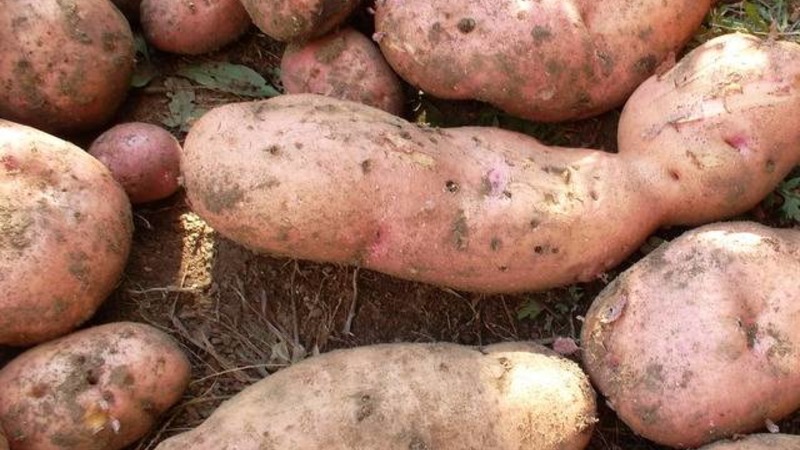
Ripening period
The culture is mid-early in terms of ripening. From the moment landing 65-80 days pass before harvest. Maturation is amicable, the growing season is not extended. Harvest safety - at least 94% of the total.When transported over long distances, ripe vegetables do not lose their presentation.
Yield
The productivity of culture is undeniable and exceeds the usual standards. At least 450-500 centners are harvested from 1 hectare. Each bush forms 6-8 tubers, one of which weighs at least 500 g. The total mass of tubers is 3-4 kg.
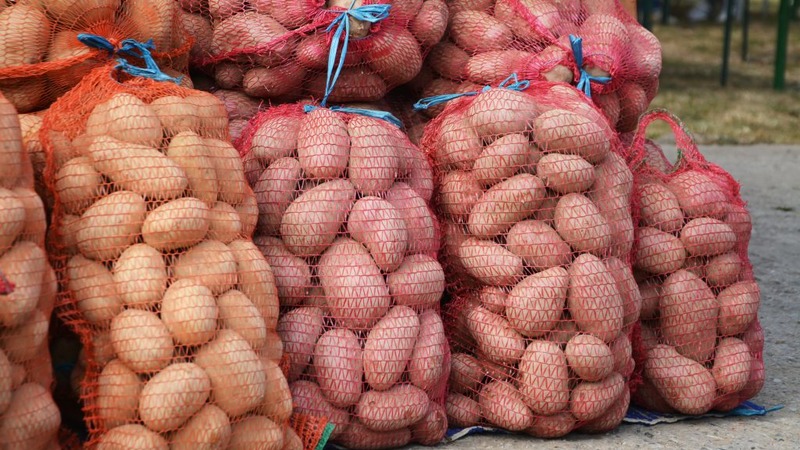
Disease resistance
The culture has no immunity to fungal infections: Alternaria, late blight. But practically not affected by viral diseases.
Demanding climate
The fact that the plant was bred in areas of risky farming speaks of its hardiness and quick adaptation to an unfavorable climate. Potatoes are grown throughout Russia, including Siberia, but they are especially popular in Transbaikalia.
Advantages and disadvantages
The culture has been known for over half a century thanks to its strengths:
- the ability to fully develop in any climate;
- drought resistance;
- frost tolerance;
- heat resistance;
- uncomplicated agricultural technology;
- high productivity;
- excellent taste;
- excellent presentation, large tubers;
- long storage;
- long-term transportation;
- versatility in application.
Of the minuses, a weak immunity to fungal diseases is distinguished.
Differences from other varieties
The main difference and advantage of potatoes is its high yield, size and weight of tubers. Noteworthy is its extraordinary resistance to adverse factors, which makes it possible to plant it even in Siberia.
Reference! Lapot potatoes do not have an originator and are not listed in the State Register. It is impossible to find planting material in a specialized store. Private vegetable growers independently distribute Lapot potatoes.
Features of planting and growing
The characteristic of the variety says about its unpretentiousness. Those who have grown Lapot in their gardens confirm this fact and advise beginners to plant the culture.
Preparing for landing
Planting material begins to be prepared in 1 month. Potatoes weighing no more than 100 g are selected and carefully inspected for visible damage or changes. The spoiled tubers are disposed of, the rest are laid out in a bright room for germination. The optimum temperature is at least 15 ° C.
During germination, the skin of the tubers becomes greenish. This indicates the accumulation of solanine in the skin, a poisonous glycoside. It scares away rodents from the sown beds, so there is no need to worry about the safety of the seed.
The tubers are planted as soon as the sprouts reach 2 cm. Under optimal temperature conditions, the sprouts will form strong and give quick shoots.
Reference! Those sprouts that have formed on the tubers during storage are subject to mandatory removal.
Immediately before planting, the seed is treated with the Epin growth stimulator and sprayed with Fitosporin to protect against fungal infections.
Ground requirements
The culture takes root and bears fruit in soil with any composition. A prerequisite is double digging of the soil. The first time it is dug up in the fall after harvesting, then in the spring before planting. In loose soil, potatoes sprout faster. In addition, when digging, the larvae of pests that are dangerous for seedlings are destroyed.
Timing, scheme and landing rules

Sowing material is planted at the end of April, if we are not talking about Siberia. Here, sowing can be postponed until mid-May, until the soil warms up to at least + 7 ° C.
Planting is carried out in clear, sunny weather in pre-prepared holes, at the bottom of which a little wood ash is placed. The depth of the holes is 8-10 cm.
Planting pattern: 35 cm - distance between seedlings, 65-70 cm - between rows. With this planting scheme, it is convenient to take care of the seedlings in the future.
The nuances of care
To obtain a rich harvest, standard procedures are performed, which boil down to watering, weeding and hilling. Do not forget about top dressing.They not only increase fruiting, but also strengthen the immunity of plants.
Watering and weeding mode
Water the plant at least 3 times per season: during budding, during flowering and after. On hot and dry days, the amount of watering is increased. Foliage wilting serves as a signal. Water the seedlings immediately as soon as you notice lethargic leaves.
Sprinkler irrigation is considered the best irrigation. But with this method of watering, starting in August, moisture is supplied early in the morning so that the foliage has time to dry out by evening. Otherwise, the occurrence of fungal infections cannot be avoided.
reference! Sprinkler irrigation is a method of irrigation when water under pressure is sprayed over the plant and falls on it like raindrops.
After watering, the moistened soil is loosened and freed from weeds. Many pests and fungal spores multiply in weeds, therefore they pose a threat to the health of seedlings.
The beds cleared of weeds are mulched with sawdust or straw.
Top dressing
A week after the emergence of seedlings, the seedlings are fed with ammonium nitrate, since they need nitrogen. Nitrogen accelerates plant growth and promotes rapid foliage growth.
During the formation of tubers, plants need phosphorus and potassium, so superphosphate is used for the second feeding.
In addition to the main ones, foliar feeding is carried out, using mainly magnesium substances.
Hilling
Hilling is carried out three times per season, raking the earth from row spacing to plants. At the same time, the center does not fall asleep, they spud only along the edges on both sides. Ridge height 15-20 cm. Hilling protects tubers from pest penetration. In addition, the rays of the sun do not fall on them, because of which the potato skin turns green.
Disease and pest control
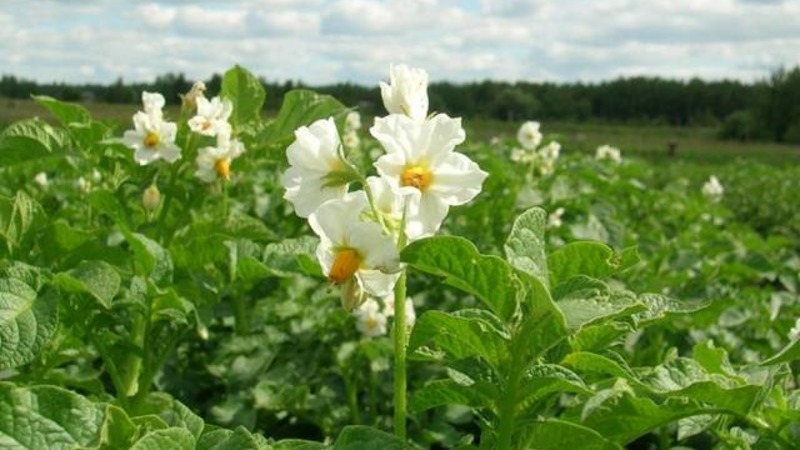
Potato Lapot has a weak immunity to fungal diseases. Prevention is carried out immediately after planting, observing not only standard agricultural practices, but also regularly spraying the seedlings with antifungal drugs. These substances include "Fitosporin" and "Osksychom". The same remedies are used for plant diseases.
Also, the risk of disease is reduced by following the rules of crop rotation. Seed material should not be planted in those beds where peppers, eggplants and tomatoes grew before the potatoes.
In addition to fungal diseases, the wireworm is dangerous for the culture. This is the larva of the click beetle, which received this name for its external similarity to the wire. The worm lives in the soil at a shallow depth and eats the roots of plants. In the fight against the pest, the insecticide "Prestige" is used, and marigolds are planted between potato seedlings, the smell of which scares off the parasite.
Harvesting and storage
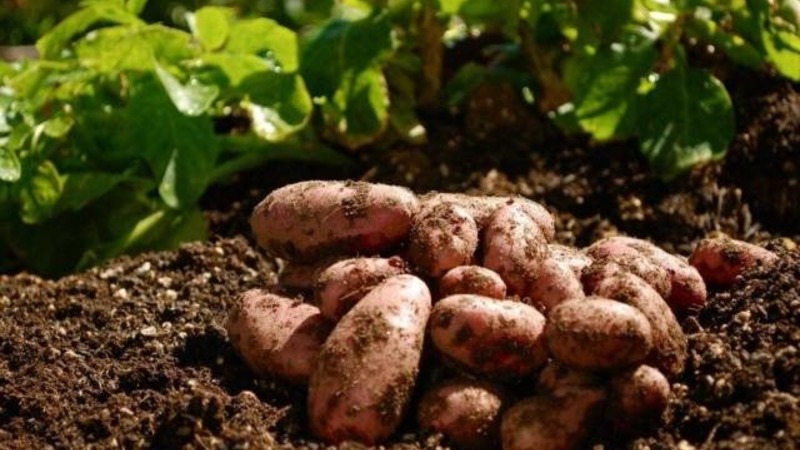
2 weeks before harvest, all foliage is removed, leaving a stem no more than 5-10 cm high. The foliage is burned because it retains bacterial spores for a long time.
The tubers are dug up with a pitchfork or a shovel and left on the site for 2-3 hours to dry. The crop is harvested in clear, sunny weather.
Storage conditions
After drying, the tubers are carefully inspected, disposed of the damaged ones, and placed in wooden boxes for further storage. The room where potatoes are stored should not be humid and warm. The optimum temperature is 2-4 ° C.
What can be the difficulties in growing
Due to the plant's susceptibility to fungal diseases, it is not worth planting crops from the Solanaceae family next to potatoes. They have the same diseases and pests - there is a high risk of infection.
The site for potatoes is chosen open and unshaded. And groundwater should not rise higher than 70 cm from the earth's surface.
Read also:
Tips from experienced gardeners and reviews
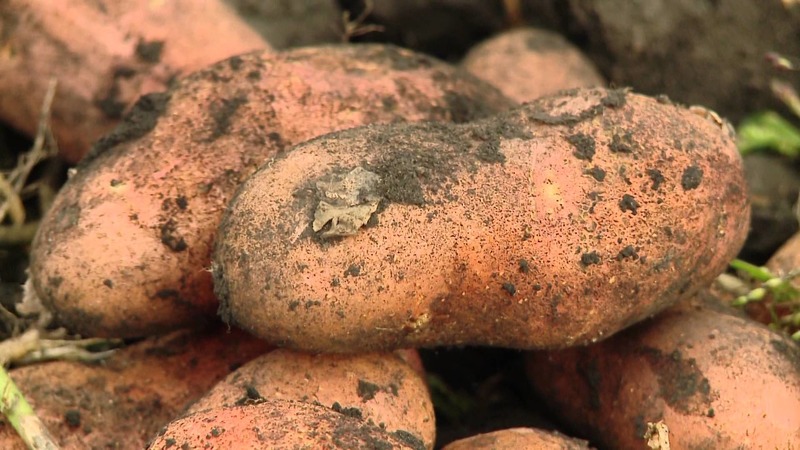
Experienced vegetable growers willingly share their advice and observations:
- Potatoes, when stored for a long time, do not like being close to other varieties.But the beets laid next to it have a beneficial effect, absorbing excess moisture.
- When planting this crop, do not forget about the size of the future tubers. If there is not enough space (less than 35 cm) between the holes, do not expect large potatoes.
Positive feedback from gardeners leaves no doubt about the reliability of the culture.
Mikhail, Kazan: “Potato tubers Lapot are simply gigantic, as in the description of the variety and in the photo. When I planted it for the first time, I couldn’t believe my eyes: a few potatoes - and a full bucket! After cooking potatoes Lapot remains white, does not darken. The taste is excellent, moderately sweet. This is my favorite potato. "
Ekaterina, Chelyabinsk: “I always wanted to see what Lapot potatoes look like. When she saw it, she did not believe it. Very large potatoes. Despite the mass, they are tasty and suitable for any dish. My favorite is oven baked potatoes. Caring for him is simple, but it is required to regularly carry out prophylaxis against late blight ”.
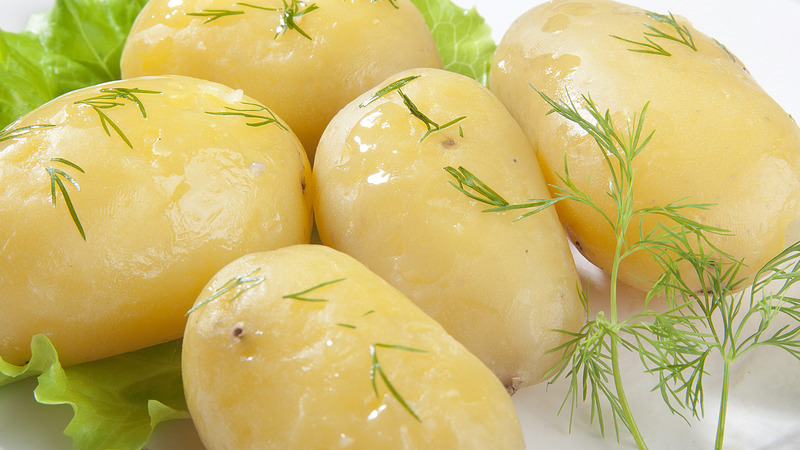
Conclusion
Despite the fact that Lapot potatoes are not included in the list of the State Register, they are as popular as they were half a century ago. The culture fell in love with vegetable growers for its high yield, the ability to develop in harsh conditions and ease of care. And the weight category of tubers allows this potato to be ranked among the champions.